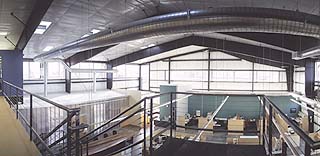
Surveys
DJC.COM
July 29, 2004
Contractor finds silver at new headquarters
Charter Construction

Firmani
|
Charter's 12,000-square-foot, $1.3 million building in Seattle's Georgetown neighborhood embodies dozens of green elements and practices, from recycled concrete in its foundation to a sensor-operated cooling vent in its roof.
Charter followed the U.S. Green Building CouncilÃs LEED program throughout construction. The building is in line to receive a silver rating from the agency, which would make it only the fourth A/E/C company headquarters building in the country with LEED certification.

Photo courtesy Charter Construction
The interior of Charter’s headquarters has open space, high ceilings and extensive windows, reducing the need for lighting.
|
Charter's decision to seek a LEED silver rating stemmed from a desire to learn first-hand the pros and cons of sustainable building from both a contractor's and an owner's point of view. Project cost comparisons during the design phase proved going green would cost about the same as a similarly sized structure using traditional building methods, and the project team was committed to taking on the added administrative efforts to become certified.
Red outside, green inside
The building, built on recycler SeaDruNar's old site, has deep red metal siding that blends with the older brick warehouses in the neighborhood. The interior is designed to encourage collaboration between project teams and takes advantage of open space, high ceilings and extensive windows.
| Interested in building green? |
|
Building an environmentally friendly building — for your own firm or for a client — is a rewarding experience, but not without challenges. Contractors used to performing in a low-bid environment should commit to a more collaborative process, especially if seeking LEED certification from the U.S. Green Building Council. “It’s important not to be a passive participant in the process,” said Eric Jackson, a Charter project manager who helped coordinate the company’s headquarters construction. “As a contractor, you really need to be committed to putting in time and research.” Contractors and other project team members involved in LEED projects can visit the U.S. Green Building Council’s Web site (www.usgbc.org) for more information about the program. Contractors and consultants who are already accredited LEED professionals and whose firms are USGBC members can take part in the monthly Seattle LEED Users Group round table. SLUG meets the second Tuesday of every month to discuss LEED credits and get advice on the documentation process. For more information, visit www.usgbc.org/chapters/cascadia/events.asp#seattle or contact Doug Smith at Abacus at (206) 625-7474 or dcs@abacus-engr.com. — Frank Firmani |
Before three SeaDruNar structures were demolished, Charter invited a number of companies that specialize in reusing old building products to salvage the existing radiators, light fixtures, doors and cabinetry. This diverted 189 tons of material from area landfills, saved Charter more than $15,000 in dumping costs and earned Charter credits towards its LEED certification.
Concrete from the existing structures was taken to a facility to be crushed, and in turn, Charter was given concrete for its building's foundation that used fly ash and recycled water in its production.
Charter used a number of materials it had salvaged from past jobs. A 24-foot-long redwood conference table uses four glu-lam beams that were rejected from a residential project four years ago. Another conference table was crafted from unused panels from a church project. Stair treads leading up to the buildingÃs mezzanine were leftovers from a renovation Charter performed at the Pike Place Market.
Office desks, chairs, shelves and file cabinets are remnants from area dot-coms that went out of business. Overall, nearly $45,000 was saved by using salvaged products.
Keeping cool
Energy efficiencies in the building abound. An economizer detects the building's interior temperature and opens a large vent in the ceiling to expel warm air when the temperature begins to rise. High ceilings, skylights, numerous windows and few interior partitions allow for 95 percent of the building's light to be natural. The few hanging lights inside the main building area operate on sensors, switching on when outside light is not sufficient. Lights in the restrooms activate when the space is occupied, and automatically turn off when it's not.
Drought-tolerant plants surrounding the building require no irrigation system. Dual flush toilets and waterless urinals conserve even more water.
The building helps counter the effects of "heat islands" — dense urban areas of asphalt and buildings that raise temperatures. A white roof reflects sunlight instead of absorbing it. A geogrid, or grass parking area, replaces heat-absorbing asphalt.
Still keeping it green
Even though construction of the building was finished last summer, its occupants continue to promote sustainability. Bins throughout the building encourage recycling of paper, cans, glass and other materials, and environmentally friendly building methods are practiced as a rule on all of Charter's jobsites.
Charter employees are encouraged to further their education through sustainable building classes and programs, and the company financially supports these efforts.
Frank Firmani is the founder and president of Charter Construction.
Other Stories:
- Conditional closures — another cleanup remedy
- Washington tests watershed management
- Todd Pacific halts a dirty waterfront legacy
- Going green? Try calling on your contractor
- Emerald City must fight to stay green
- Seattle prepares to ‘re-green' 2,500 acres
- Washington's new paint law gets the lead out
- Putting a price tag on nature
- South Lake Union: a model for sustainability
- Guy Battle: design and build to suit your climate
- Government finds gold at Sea-Tac Airport
- Quick Duwamish cleanup begins with teamwork
- 2004: A great year for the local environment
- Getting to compliance with a systems approach
- Don't let your site be taken to the cleaners
- Salmon get a boost from technology
- Low-impact development comes to Pierce County
- Energy Star label now ready for homes
- Improving traffic flow for fish, people
- Troubling times for Hood Canal's waters
- Utilities to study energy coming into homes
Copyright ©2009 Seattle Daily Journal and DJC.COM.
Comments? Questions? Contact us.